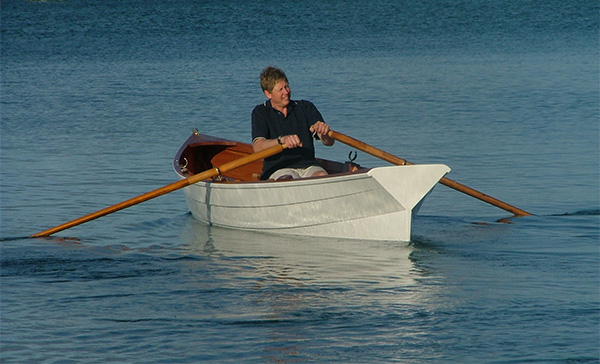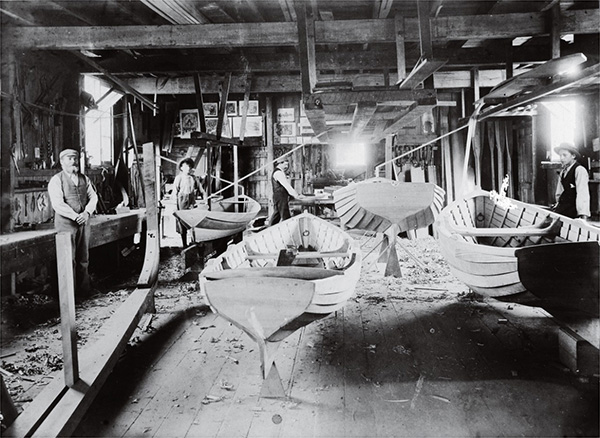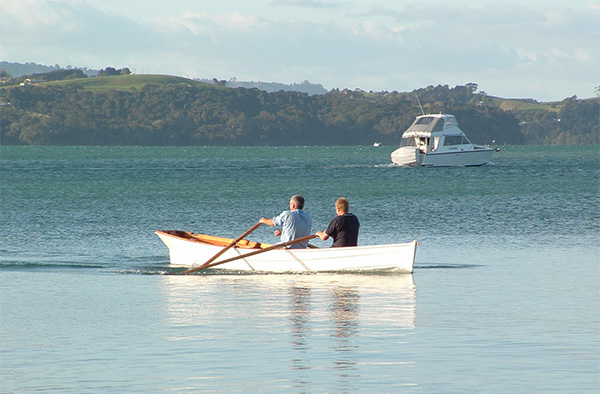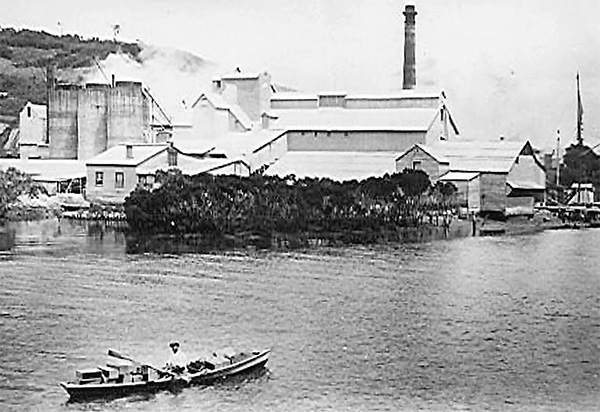Jade River: A History of the Mahurangi
Ronald H LockerFirst published 2001. Published online 2014–. This online edition is a work in progress…
Pages 169–174in printed edition
Mahurangi’s elegant punt

Revival of an Icon: The elegant Mahurangi punt is one of the two natural icons of the Mahurangi, the other being the Wilson Cement Works. Here Boatbuilder Kerry Miller is at oars of his Penelope, during her sea trials at Sandspit. image Miller family
On the Mahurangi, getting to work, to school, or to social events; meeting the steamboats, cream launches or neighbours; or bringing home necessities such as firewood, usually meant rowing, often for miles at a time. Some of the more epic rowing stories are told in the next chapter. For the shoreline families, a good rowing boat was more essential than a horse. Even in later times, launches remained a luxury for most. Settlers seem to have made little use of small sailing boats that might have saved well-worked muscles. The 1865 regatta could not summon up one proper sailing boat for the scheduled race.
There are only a few basic designs around for rowing boats, each with its origins in the old world. In northern Aotearoa the choice was dictated by the needs and means of the settlers. The scow emerged as the answer to heavy transport, capable of working the shallow harbours and beaches. For the same reason the settlers took to flat-bottomed rowing boats: the square-ended skiff or punt. Ralph Sewellauthor of Flat-Bottomed Boats, builder of the brigantine Breeze , and earlier the centreboard ketch Ripple, in which he regularly attended the first, revived Mahurangi Regattas put it well:
The flat-bottomed boat is the wheelbarrow of the sea.
Such a boat is ideal for mudflats and easily constructed by the amateur. On the Mahurangi first-class materials were at hand: kauri planks and pōhutukawa knees.
The flat-bottomed skiff or punt, a universal design, is the easiest to build and capable of carrying big loads. It has long been favoured by fishermen. French fishermen once assembled them from lumber kits on the beaches of Newfoundland. My uncle used one on the Mahurangi for the same purpose. The broad stern is suited to handling mullet or flounder nets. But the heavier models could be ponderous to row. It was the Mahurangi punt, with its superior rowing qualities that became the standard family transport and workboat on the harbour and river.
The advantages of the form in ease of construction and usefulness, made it inevitable that it be invented and re-invented in various places. I have seen it in variant forms as the common working boat on the canals of Buranoan island of the Venetian Lagoon, and on the canals of Oviedo on the Atlantic coast of Portugal.
The local variant is known as a Mahurangi punt. The name is familiar of old to some local people, and indeed was used in the regatta of 1868. I do not remember the term being used around Mahurangi West in my youth. Mahurangi punts were so ubiquitous that they were generally just boats or flatties in my recollection. The term punt was also long-used on the Kaipara. Punt may strike many as a misnomer for such an elegant craft, appearing to suggest a blunt-nosed work horse, or the refined form of such as those poled along the Cambridge Backs. Then there is the Deal galley punt and the Falmouth quay punta small reward is offered for the etymology of the punt of Falmouth quay punt; both sharp-bowed but about as different from each other as they are from the Mahurangi punt. Although the term punt for the Mahurangi craft was probably used to differentiate its flat bottom, despite the Falmouth quay punt being about as deep-keeled as any craft could be.
The local design, in the detail of its martini-glass transom, is peculiar to the Mahurangi, while those of the Kaipara landed the top strake at a lesser angle and generally appear to have been higher wooded. One once stood in the weather between the Matakohe Hall and the museum. Its label recorded it was built in 1956, for £35, by the grandson of E Thompson of Aratapu, who first introduced the design to the Kaipara. At fifteen feet it is smaller than a Mahurangi boat. It is otherwise typical, except for a stern seat with a back rest, set a metre forward of the transom (reminiscent of a Thames skiff, and probably better for the balance of the boat). A sparkling new copy in kauri is displayed in the Matakohe Museum, next door.

Relative or Forebear: Author Dr Ronald Locker doubts the claim that Swedish settler and Aratapu boatbuilder Erik Thompson introduced the punt form to the Kaipara, given the lateness of his arrival in Aotearoa. But that Thompson was a fine boatbuilder was attested to in a letter to him by Ernest Shackleton dated 10 April 1909, and by the craft in this image, in which close inspection of the punt, upper left, reveals a demure—but not quite the petite, martini-glass posterior of the Mahurangi punt—transom. image Dargaville Museum
Erik Thompson was a Swedish ship’s carpenter, who in 1870 commenced building small boats at Aratapu on the Northern Wairoa. He built boats for Shackleton’s Nimrod expedition, but not for the later, 1914–17, Endeavor expedition that climaxed with the epic voyage of the James Caird to South Georgia. He also built a steamboat or two. His son Charles took over in 1895, and Charles’ son in turn, at Dargaville. Other small boat builders there would have turned out punts, and probably the big builders as well, as side-lines. A photo of Brown’s, the largest yard on the Wairoa, has two upturned punts in the foreground, perhaps their product. Dick Scott’s Seven Lives on Salt River, is abundantly illustrated, and many of these old photos, including the frontispiece, show typical punts. It is clear that they were the standard work-boats of the Kaipara.
A Henry Winkelmann photo of 1893 shows a typical punt belonging to the Osbornes at Tryphena. A photo of 1904 shows a punt on the beach at Russell. This one is small, and unusual in having only two rows of planks, and one pair of rowlocks, set outside the gunwale. A history of the Manukau has photos of them there. My cousin remembers two at French Bay. It is clear that similar punts were used all over the north of the North Island, and I suspect in many other estuaries and shallow harbours.
It is improbable that we shall learn who brought the design to New Zealand, or when. The oldest record I have is local. It is also the oldest local photo I have seen, dated 1862. It contains an unmistakeable longboat drawn up below the Sandspit, near Darrachs Bay. Punt races have long been a feature of the Mahurangi Regatta. The rowing races of the 1865 event are all advertised as for “flat-bottomed dinghies”. The definitive statement of what these really were comes from an account of the 1868 regatta, the feature of which was the punt race for women:
The boats were not built for racing but were the ordinary punts used by the settlers in their daily avocations.
A good rowing boat needs length on the water-line, and the fine lines that this permits. Above all, it should avoid generating turbulence at the stern. The square transom of a loaded dinghy fails miserably in this respect, creating a fearful suction, which slows the boat between strokes. Streamlined flow is maintained in the Mahurangi punt by bringing the lower side-planks together at the stern to form effectively a double-ender under water. But the two upper rows of planks are fitted to a small triangular transom, giving a Y-shaped stern, with a useful elongated stern seat. A Mahurangi lady could sit enthroned there in style. With just a rower, the rockerfore-and-aft curvature of the bottom of about three inches, allows stem and stern to just clear the water, and the boat skims along. Even as a small boy I preferred to row the heavy punt rather than the clinker dinghy. When the punt is loaded it maintains the good fluid dynamics of the double ender. Its use in a crosswind, however, requires careful attention to fore-and-aft trim, in the absence of any keel whatever.

Over-Oared: Being relatively lengthy and invariably built with two pairs of rowlocks encouraged the modern misconception that Mahurangi punts were intended to routinely be rowed by two oarsmen. When they were rowed with two pairs of oars at Mahurangi Regattas, a child got to be placed in the stern to correct the ruinous tendency of the too-deeply-buried bow to seek. image Miller family
Mahurangi punts were long for a craft designed for a single oarsmanthe Mahurangi Magazine style is to treat the man/men suffix in the Old English, gender-neutral manner, generally 18–21 feet, allowing for fine lines. The sides flared out from a beam of about three feet on the bottom to four feet at the gunwale. Probably most were not built to a drawing, the lines being laid out by eye as the builder thought fit. Some had a better eye for line than others. The best, with a good flare and rocker, were quite elegant, the worst stolid or even ugly. There was, I am told, a Mahurangi East and a Mahurangi West type, the latter having more flare to the sides. The bottoms were of three-quarter-inch kauri planks, cross-battened and flat athwartships. (The one I have just restored was unusual in having a three-quarter-inch transverse curvature). The sides were of half-inch planks, fastened with copper nails to a straight-sided pōhutukawa stem and knees. Copper nails were clenched over washers along the plank overlaps, as in clinker construction. The standard antifouling paint was tar, applied over the bottom and lower side planks. Most were painted on the bottom inside, but some harder worked boats were also tarred there as well. My grandfather would sprinkle on a little cement to take the tack out of the tar. The tar kept the wood-boring worms at bay and also sealed the joints. External bottom battens were sometimes added to reduce the wear due to grounding and to launching over shelly mud. There were always two sets of rowlocks, but to allow a passenger’s weight in the transom to be balanced, rather than for two oarsmen to simultaneously row—that was a regatta day practice and required a small person in the stern seat to balance the bow rower. A primitive sail of calico was often carried, on a short mast, stepped through a hole in the forward thwart, and unstayed.
My grandfather had one horse, but two punts. The first he got from his father-in-law, George Scott, boatbuilder. His neighbours, Fred Jackson, George Jamieson and Jim Scott, all had boats so similar that I believe they were made by the same hand. Grandfather laid it up when the bottom was rotten and built a new one. Ernie Struthers liked this one, so it was sold to him and grandfather built another. Billy McElroy took a fancy to this second one and bought it. Grandfather built a third, lean and light, it is said with the intention of winning the rowing race at the Mahurangi Regatta. He let Fred Anderson, a strong man, compete in it, but he did not win. However the boat served my grandfather well for the rest of his life. These boats were built with a few primitive tools. I remember the old wooden planes, spokeshaves and broken chisels, mouldering in a box in the cowshed.

A Good Rowing Boat: Even with a good load aboard, the Mahurangi punt rowed sweetly thanks to its canoe-like submerged form, achieved by running the bottom pair of side planks together, forming the stem of the Mahurangi punt’s unique martini-glass transom. Here ‘Willie’ Hamilton son of William Hamilton rows produce from the family orchard past the Wilson Cement Works on his way to Warkworth, allowing the photographer to simultaneously capture both of what are now Mahurangi’s two natural icons. image Family archive
A virtue of the punt was the ease with which it could be launched across a mudflat. Far too heavy to carry, it skated well. The trick was to rock it fore-and-aft to break the grip of the mud, and then push hard to get it moving, and then maintain the momentum. In this way it could be launched at low tide by two people over hundreds of metres of mudflat, provided there were not too many patches of eelgrass, which collects sand and greatly increases friction.
The revival of the Mahurangi Regatta has renewed interest in these old boats, although only a few remain watertight. Some of these have appeared on regatta day, one nicely restored, others in shabby condition. They cannot compete, however against sleek plywood skiffs of modern design. There were some sleek models around long ago. The epic row to Auckland by James Clare in 1866 (see below) was done in “a flat-bottomed racing skiff, only one foot deep, two feet wide at the bottom and 24 feet long”, borrowed from Sullivan. It was perilously short of freeboard for such a passage, made in rough weather.
In 1989 I recovered two long-abandoned punts from reed-beds on the McElroy seafront. They were just within the possibility of restoration, and after some effort were put into dry storage in my basement. I have since restored the better of the two ruins, making full but unobtrusive use of modern materials. It is a square-end version of 15 feet. It was recovered from the Pukapuka boundary of the McElroy property. Builder and owner are unknown. Its last lease of life had come from patching the worm holes in the bottom with apple case. It was re-launched for the 1993 regatta, where it and the old Dawson boat were the only representatives of the old breed. Another boat I put in storage is a seventeen-foot lightweight Y-stern model, designed for speed rowing. It was built for Billy McElroy by Fred Anderson, converted in old age to a sailing boat, and finally abandoned in the reeds of Brownes Bayaka: G Brownes Bay; Gordon Brownes Bay.
Fred Anderson was well known as owner of the cream launch, but he was versatile. In his time he worked as a bushman and built houses and boatsfrom the 1930s. His son Graeme remembered him building a punt each winter, and helped in the years after he left school (1955–60). The punts were built right way up, without plans, but using measurements from older boats.
Eric Viall also built punts. Brian Dawson has one of these in useable condition. It was built for Bob Wech, who pitsawed the timber. He owned a mill but wanted to show his sons the old art. Eric built another punt for Harold Edwards. This did service as the school boat, collecting children from the upper Mahurangi for school in Warkworth. It is now owned by Tom Morrison. Others built their own.
There was another quite distinct type in the area: the Matakana punt. One fine example remains, built on the Eden Creek by Duncan Knaggs, formerly one of Davy Darroch’s shipwrights. It was bought eventually by Harry Parry, and passed to his nephew, Eric Barker of Pukapuka. It is a very impressive boat of twenty feet, heavily built. It is a curious hybrid. Topsides it resembles a ship’s gig, with a dinghy transom and curved stem and knees. Only the bottom is punt. Because it has spent its life out of the weather, it is unusually well preserved. Eric presented it to the Warkworth Museum in 1993. It is probably the last of its kind.
Mahurangi Action intends to compile a register of the surviving punts. Mark and Lindsay Kirby donated theirs to the organisation. It is an Anderson punt, long resident at Rodmersham, and the best-preserved survivor. Its restoration was completed in 1993. It is intended that it will appear at regattas.
It is a pity that a boat of such importance to the north does not figure in the collections of the Auckland Maritime Museum, or the museum at Warkworth. It is to be hoped that these deficiencies will be corrected.
If this essay seems more suited to a boat book, I plead that the Mahurangi punt played such a central role in the life of the Mahurangi, that this chapter is justified. But I should also confess that my grandfather’s old punt was the most beloved plaything of my childhood, and that in part, this is a nostalgic tribute to the breed. That boat has long since broken up, but a piece of tarry bottom plank remains nailed to my wall, in memory of good times past.
No rough-cut punt Originally titled The Mahurangi Dory, this chapter is one of only two—the other concerning Rodmersham—of Dr Ronald Locker’s that required significant rewriting.
In both cases, factual errors required correcting, but more importantly, arguments central to each were misguided, possibly as a result of prejudices lingering from the author’s upbringing. In the case of this chapter, Dr Locker bridled at the use of the term punt, which he felt was derogatory, to describe the cherished craft of his boyhood holidays. He seized upon dory, with its role as the intrepid craft working from the glorious Grand Banks schooners, both romanticised in the 1937 film Captains Courageousof the 1897 novel with the same name by Rudyard Kipling, as the ancestor of the Mahurangi punt. But aside from being nominally double-ended, having flared sides amidships and the dory’s—all-but vestigial—flat floors, the two craft, in function and form, could not be more different, although arguably each could have evolved from a similar flat-floored ancestor. Dory denotes a high-sided deepwater craft, at home—once sufficiently ballasted by catch—in open water.
The Mahurangi punt and those of similar regional form were flat-bottomed—flat fore and aft, as well as from chine to chine—for minimal draft in shallow tidal estuaries to the point of readily sliding across wet mud, even loaded. They were low-wooded and of low bow with minimal flare, for conditions where wind rather than cresting seas is the principal enemy of the oarsman. Posthumously rewritten, the aim here, as was Locker’s, is to do justice to the elegant Mahurangi punt that so sublimely served the needs of the settlers.

Beautifully done
That, from the publisher, is praise indeed!